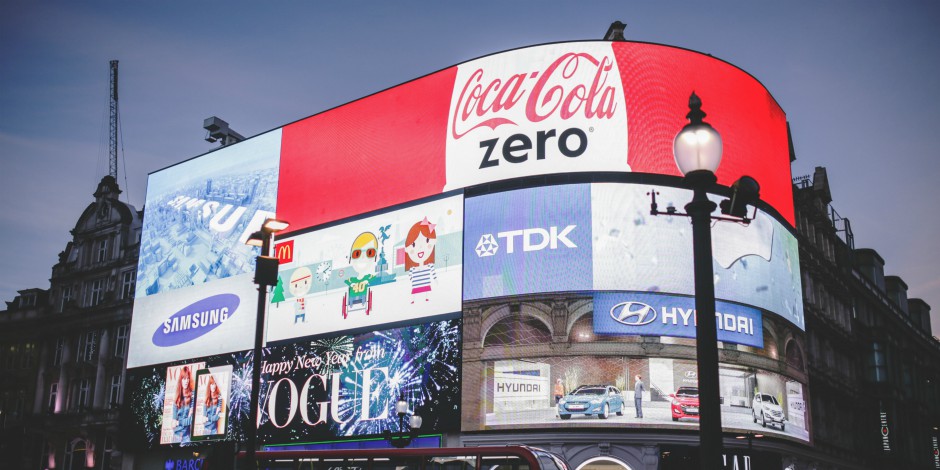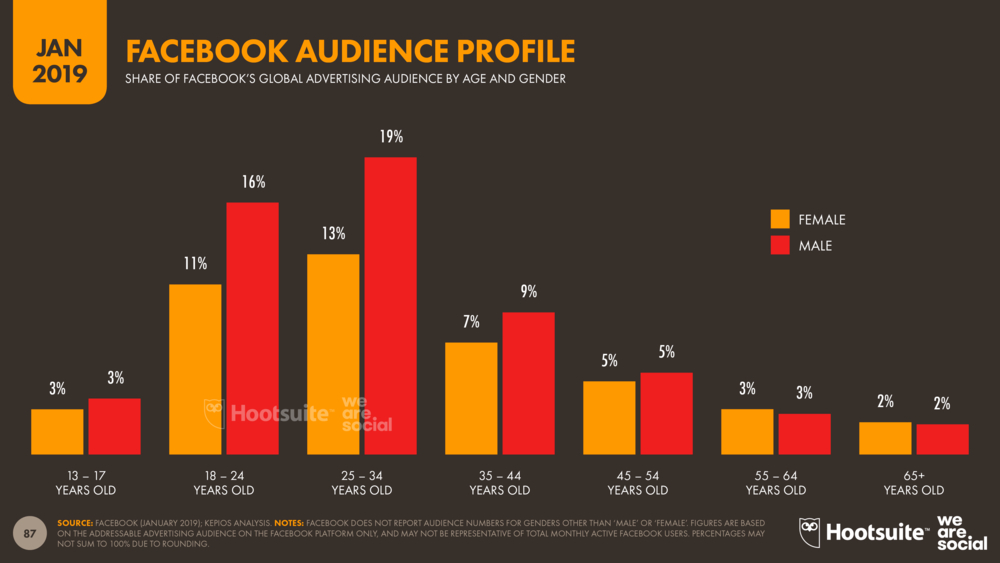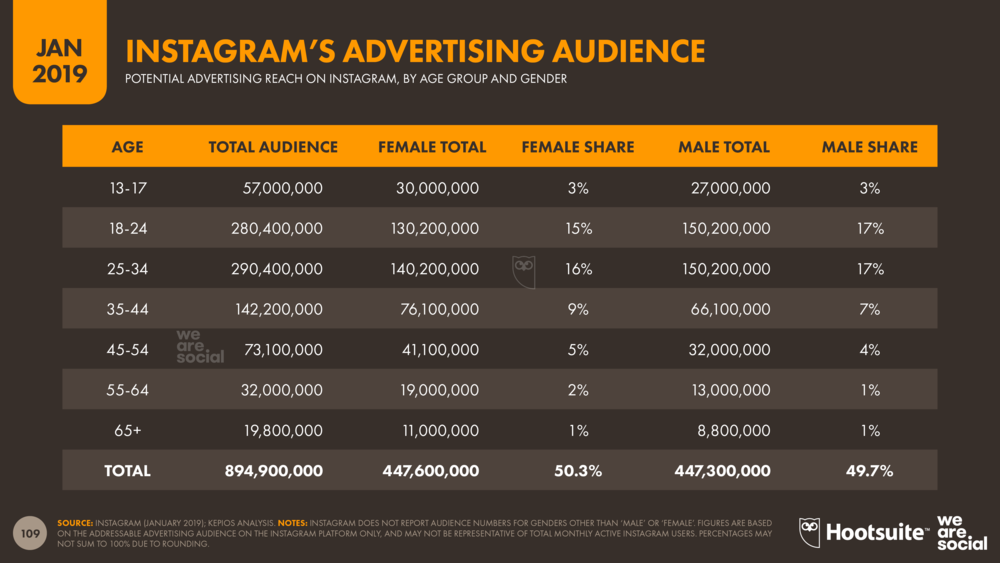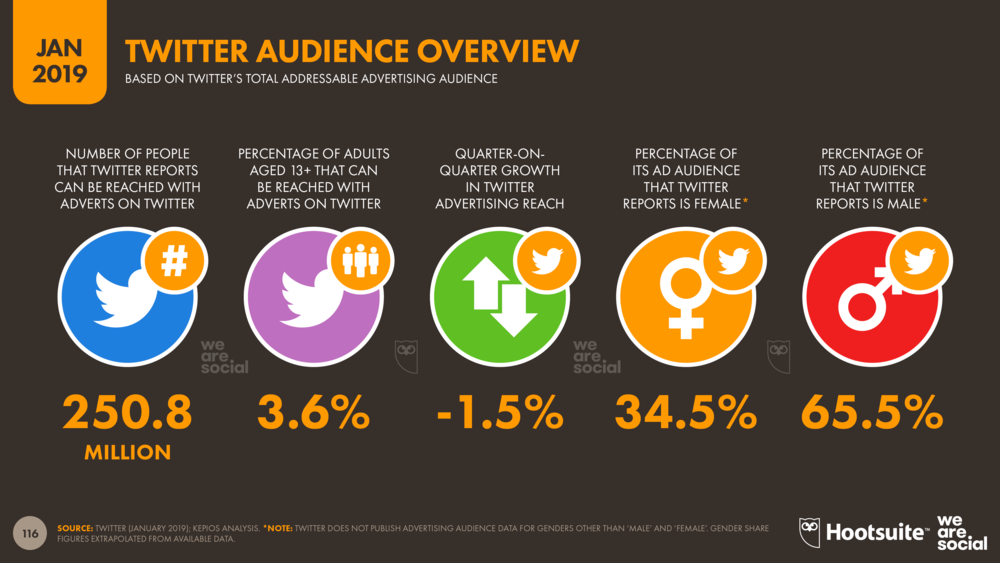Social media advertising is a must if you’re looking to reach a new, targeted audience—fast.
Of course it can be scary to move from an organic social strategy to putting real money on the table. So, it’s important to understand all the options.
In this guide, we explain how to use the various types of social media ads to achieve real business results while maximizing your spend.
Table of contents
Types of social media ads
Facebook ads
Instagram ads
Twitter ads
Snapchat ads
Linkedin ads
Pinterest ads
Youtube ads
Social media advertising costs
Social media advertising tips
Bonus: Download a free guide that teaches you how to turn Facebook traffic into sales in four simple steps using Hootsuite.
Types of social media ads
All the major social networks offer advertising options. That doesn’t mean you should use all of them.
When thinking about which social networks to use for advertising, look at which ones perform well organically. Networks where your content naturally strikes a chord with fans are an obvious choice for your first social ad campaigns.
When choosing where to place your ads, it’s also helpful to know which networks are most popular with your target audience.
Pinterest, for example, has far more female than male users. If you’re targeting a younger crowd, you’ll likely find them on Snapchat and Instagram.
Here’s a quick summary from the Pew Research Center showing who’s using which social networks in 2019.
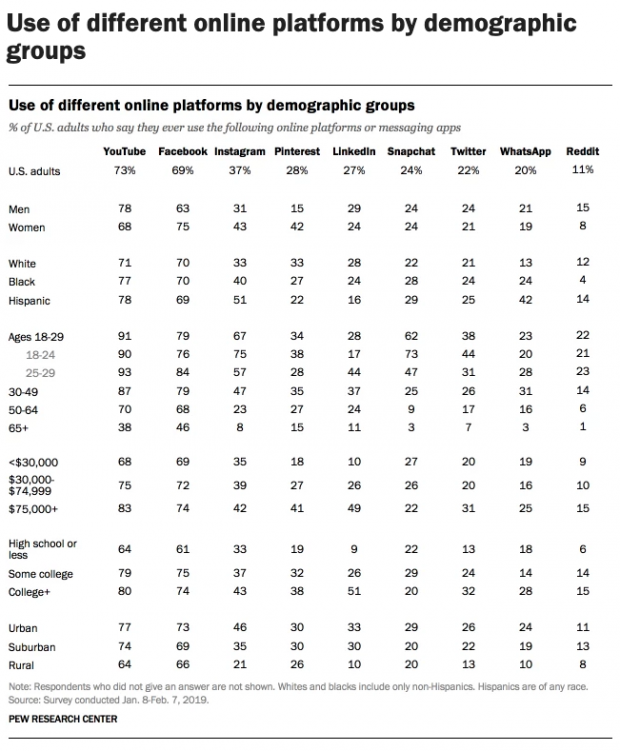
Now that you have a sense of which social networks are a demographic fit for your business, let’s look at the types of ads each network has to offer.
Facebook ads
Facebook ads are designed to help you achieve one of three broad types of campaign objectives:
Awareness: Build brand awareness or increase reach.
Consideration: Send traffic to your website, increase engagement, encourage app installs or video views, generate leads, or encourage people to communicate with you on Facebook Messenger.
Conversion: Create online conversions, make catalog sales, or drive foot traffic to offline stores.
Audience considerations: Facebook is popular across demographics and offers detailed targeting options. This makes it a great platform to get started with social media advertising.
Photo ads
In addition to a photo, Facebook photo ads include 125 characters of text plus a headline and link description. They can also include a call-to-action button like Shop Now or Send Message.
You can create your photo ad in Facebook Business Manager, or simply promote a post with an image from your Facebook Page.
Quick tip: Facebook photo ads work really well for showcasing new products or services. Show people using your product, rather than a simple photo of the product itself.
When you see how this hoodie is made, you'll understand why it's so awesome:
Posted by Design Crowdfunding Projects on Monday, March 18, 2019
Video ads
Facebook video ad options range from short mobile video ads up to 240-minute promoted videos designed to be watched on desktop. With so many options, it’s critical to have solid goals and understand who your target market is and where your video will reach them.
Facebook video ads can work well in conjunction with a TV ad campaign. Even if T.V. is not part of your marketing mix, video ads can be a great way to draw people in. Use compelling visuals that highlight the best parts of your brand.
Quick tip: Short videos tend to have higher completion rates. However, if you’ve got a compelling message you can go a little longer.
Rareform uses mobile Facebook video ads to highlight its unique value proposition. The company makes bags out of recycled billboards. Their video ads get a 19% higher return than ads without video.
We're saving the planet one bag at a time! ♻️✌️???? Over 1 million lbs of billboard repurposed so far!Use code 'FB20' for 20% off sitewide today! → https://bit.ly/2NYcbiF
Posted by RAREFORM on Tuesday, October 2, 2018
Stories ads
In this full-screen format, photos display for six seconds, and videos can last up to 15 seconds.
You can’t specifically select Facebook Stories ads on their own. They’re included as a possible placement when you select Automatic Placements when creating your ad.
Quick tip: Stories only last for 24 hours, so this is a great format for in-the-moment marketing like limited time offers. The majority of people Facebook surveyed said they wanted Stories ads to be “quick and easy to understand.” Keep things simple.
For example, the clothing brand tentree used a Facebook Stories slideshow ad with six photos to show off six different men’s hats. The campaign had a 70% lower cost per product page view than other digital ads.
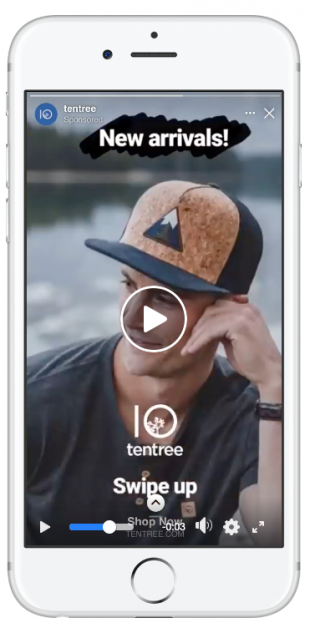
Carousel ads
A carousel ad lets you include up to 10 images or videos, each with their own link, all in one ad.
Carousel ads work well to showcase different features of a product, or to explain a step-by-step process. They’re also a great way to present multiple products.
Quick tip: Use the different elements in your carousel ad together to present a compelling, effective story or message.
Pack and Go! – your lightweight and packable companion for every adventure.
Posted by Jack Wolfskin on Monday, April 8, 2019
Slideshow ads
A slideshow is an ad that creates a video from several static images—your own or stock images that Facebook provides.
Slideshows offer the compelling motion of video, but require no video-specific resources to create. If you’re not ready to try video ads but want to move beyond static photos, slideshow ads are a great option.
Happy Socks uses slideshow ads to show off their colorful product in an eye-catching way.
Easter gifts to dye for ????✨Shop now at HappySocks.com
Posted by Happy Socks on Tuesday, April 2, 2019
Collection ads
A collection ad highlights your products right in the Facebook feed. The ad includes a cover photo or video plus product images with pricing and other details. This allows people to learn more about your product without leaving Facebook. When someone clicks on the ad, they go to an Instant Experience (see below).
Quick tip: Collection ads work especially well for retail and travel brands.
Instant Experience ads
Formerly called Carousel ads, these are full-screen interactive ads for the mobile feed. An Instant Experience ad can include up to 20 images or up to two minutes of video. You can include a call-to-action button with up to 30 characters of text.
Instant Experiences also include interactive features like tilt to pan.

Quick tip: Instant Experience ads can also be used to collect customer or lead information using an instant form.
Messenger ads
Messenger ads are simply Facebook ads placed on the home screen of the Messenger app. You can use them to encourage people to connect with your business on Messenger, but they can also link to your site.
Here’s how a Messenger ad looks in the mobile interface:
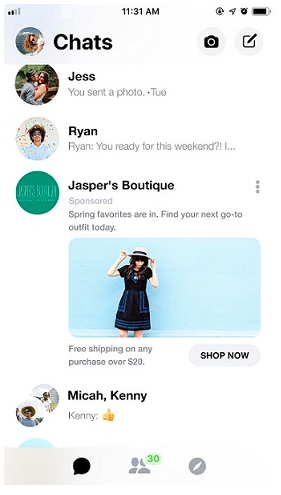
Quick tip: You can use Messenger ads to restart conversations that have trailed off. Use a custom audience of people who have previously messaged your business.
Lead generation ads
Facebook lead generation ads are mobile-only ads that include pre-populated forms. This makes it easy for people to:
sign up for your newsletter
request a free trial
ask for a quote
They’re a great tool if you’re looking for leads to pass along to your sales team, or to build your online sales funnel.
Quick tip: Ask for the minimum amount of information you need to process leads effectively, to maximize completion.
Get all the step-by-step instructions you need to set up your Facebook ads in our Facebook advertising guide.
Instagram ads
Facebook owns Instagram. So it’s not surprising that Instagram ads support the same three broad categories of campaign objectives as Facebook ads:
Awareness
Consideration
Conversion
Audience considerations: Instagram is most popular with millennials. Plenty of Generation Xers also use the platform.
The specific Instagram ad types also mirror four of the Facebook ads types:
Photo
Video
Carousel
Collection
You can create each type of ad for either the main Instagram feed, or for Instagram Stories.
Photo and video ads
Your Instagram photo or video will look like a regular Instagram post—except that it will say Sponsored in the top right. Depending on your campaign objective, you may also be able to add a call-to-action button.
Quick tip: Make sure your photo and video ads are consistent in style with the organic posts you share on Instagram. This helps viewers recognize that the ad is from your brand.
Try testing video ads against photo ads using the same content. America’s Test Kitchen found that adding motion to its ads resulted in a 45% increase in leads over the same ad using just a photo.

Carousel ads
In an Instagram carousel ad, viewers swipe to scroll through different images.
Quick tip: Make sure the images you use in your carousel ad are visually similar and tied together by a common theme. It shouldn’t be jarring to swipe between the different photos in the ad.
Look at this Carousel ad for Snag Tights. The similar images and consistent bar of text across each photo clearly connect the components of the ad and help to tell a consistent story.
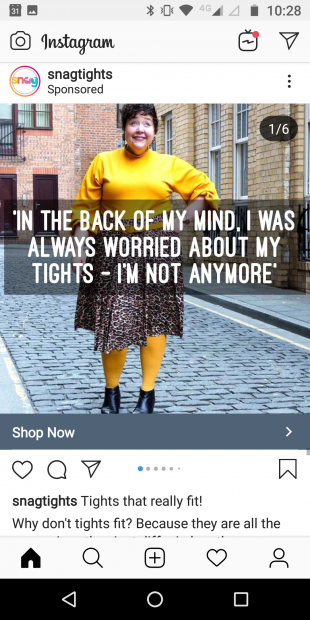

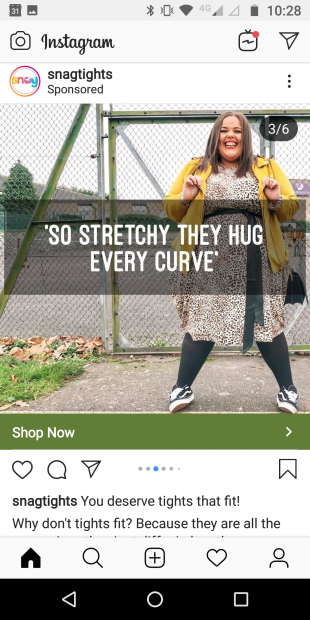
Collection ads
Just like Facebook Collection ads, these feature a cover image or video plus several product shots. Clicking on the ad directs the user to an Instant Experience.
Quick tip: Instagram Collection ads don’t include a headline, but they do allow up to 90 characters of text.
Instagram Stories ads
Instagram Stories ads can use photos or videos up to 120 seconds long. These ads display in full-screen format between people’s stories.
Quick tip: Add interactive elements to Story ads for the best performance.
Dunkin’ found in an A/B test that a Story ad with a poll sticker had a 20% lower cost per video view. Plus, 20% of people who watched the video voted in the poll. (On the very important topic of which is better: donuts or fries.)
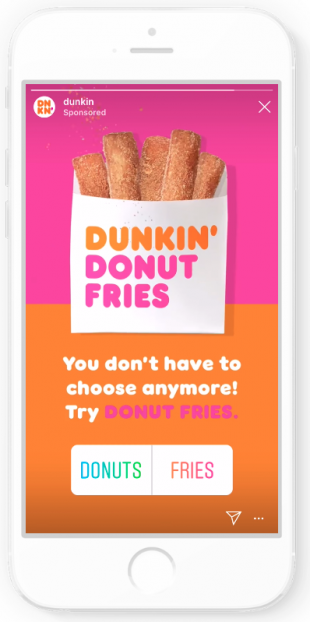
Get all the step-by-step instructions you need to set up your Instagram ads in our Instagram advertising guide.
Twitter ads
Twitter ads work towards five different business objectives:
Website clicks: Promote Tweets with Website Cards to encourage people to visit and take action on your website. You’re charged per click.
Tweet engagements: Promote Tweets with the goal of starting conversations about your brand. You pay for the initial engagement.
Followers: Promote your Twitter account and pay per follower gained.
Awareness: Promote your Tweets to a broad audience and pay for impressions (CPM).
App installs: Promote your Tweets with App Cards and pay per click to open or install your app.
Audience considerations: Nearly two-thirds of Twitter’s advertising addressable audience is male.
Twitter offers two ways for brands to create Twitter ads:
Twitter Promote automatically promotes Tweets for you.
Twitter Ads campaigns allow you to set up campaigns yourself based on your marketing objective.
Twitter Promote
With Twitter Promote, the Twitter algorithm automatically promotes Tweets to your specified audience. It promotes your first 10 daily organic Tweets that pass the Twitter quality filter. It also promotes your account to attract new followers. You can focus on up to five interests or metro locations, and let Twitter do the rest.
Quick tip: Twitter Promote mode costs $99 USD per month. Twitter says accounts will on average reach 30,000 additional people per month and gain an average of 30 new followers.
Twitter ad campaigns
With Twitter ad campaigns, you first choose a business objective that aligns with your business goals.
For example, this Chanel Twitter ad uses a video to showcase its product, combined with a website card for easy mobile shopping.
The ‘side-pack’ is a new #CHANELSpringSummer 2019 bag. Worn by two, it introduces a new way of carrying. See all the bags of the collection in boutiques and on https://t.co/rNMAuWotsI
— CHANEL (@CHANEL) March 26, 2019
You can select existing organic Tweets to promote, or create Tweets specifically as ads.
Quick tip: Run separate campaigns for mobile and desktop users to get the best conversion rates. Twitter recommends you avoid using hashtags and @ mentions in your ads so that your audience does not click away.
Get all the step-by-step instructions you need to set up your Twitter ads in our Twitter advertising guide.
Bonus: Download a free guide that teaches you how to turn Facebook traffic into sales in four simple steps using Hootsuite.
Snapchat ads
Snapchat ads can help you achieve three types of marketing objectives:
Awareness: Reach a large audience to increase awareness of your brand.
Consideration: Drive traffic to your website or app, increase engagement, and encourage app installs, video views, and lead generation.
Conversions: Drive website conversions or catalog sales.
Audience considerations: Snapchat is overwhelmingly popular with younger users. Nearly three-quarters of 18- to 24-years olds use the app. Compare that to only 25% of 30- to 49-year-olds. About 60% of the audience you can reach with Snapchat ads is female.
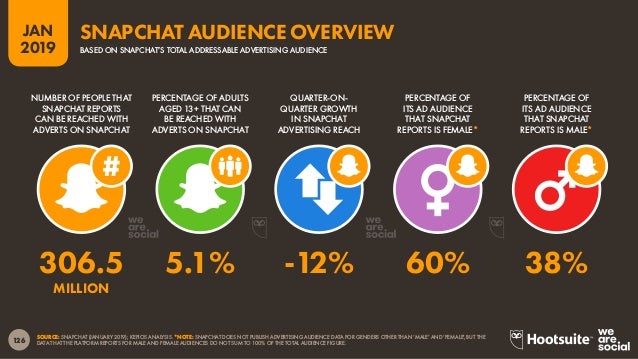
Snapchat offers four types of ads to help you meet your objectives.
Snap ads
Snap ads start with an image or a video up to 10 seconds long.
The ads are full-screen, vertical format. They can include attachments for app installs, landing pages, lead forms, or long-form video.

Quick tip: Time moves quickly on Snapchat, so aim to keep your Snap ad to five to six seconds. Don’t try to do too much with a short ad: Feature one strong call-to-action and key message.
Story ads
This ad format takes the form of a branded tile in users’ Discover feed. The tile leads to a collection of three to 20 Snaps, so you can provide a detailed look at new products, special offers, and so on. You can also add attachments with a call-to-action, so that users can swipe up to watch a video, install an app, or buy a product.
Quick tip: Write a powerful headline for your Story ad to encourage Snapchatters to tap.
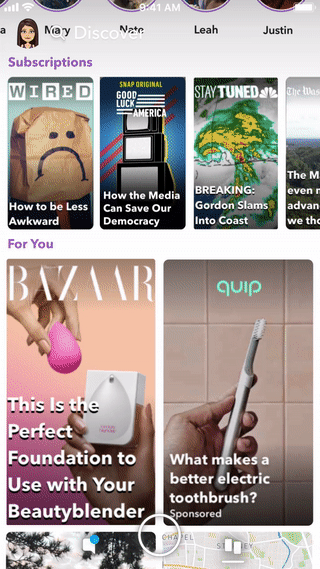
Collection ads
Collection ads allow you to showcase a series of products with four thumbnail images in one ad. Each thumbnail image links to its own URL.
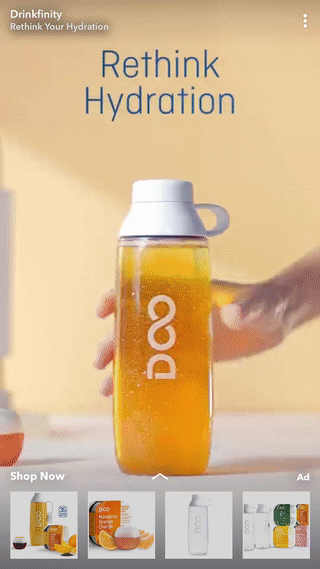
Quick tip: Keep the snap itself simple to focus attention on the thumbnails in your collection ad.
Filters
Snapchat filters are graphic overlays that users can apply to their Snaps. Snapchatters use them hundreds of millions of times per day. You can make your filter “smart,” so it includes real-time location, countdown, or time information.
Quick tip: Snapchatters use filters to provide context to their Snaps. Make sure your filter is relevant to the time, place, and purpose of your campaign. Leave room for Snapchatters’ own images to shine. Only use the top and/or bottom quarters of the screen for your filter creative.

Get all the step-by-step instructions you need to set up your Snapchat ads in our Snapchat advertising guide.
LinkedIn ads
LinkedIn ads help your business with three types of marketing objectives:
Awareness: Create more awareness of your company or brand.
Consideration: Drive website visits, increase engagement, or encourage video views.
Conversions: Collect leads and drive website conversions.
Audience considerations: LinkedIn is much more business-oriented than the other social networks in this post. It offers targeting options based on professional qualifications like job title and seniority.
You can choose from several different types of LinkedIn ads.
Sponsored Content
Sponsored Content ads appear in the news feed on both desktop and mobile. They’re used to get your content in front of a larger audience and showcase your brand expertise.
Quick tip: Headlines under 150 characters have the best engagement. Larger images get higher click-through rates. LinkedIn recommends an image size of 1200 x 627 pixels.
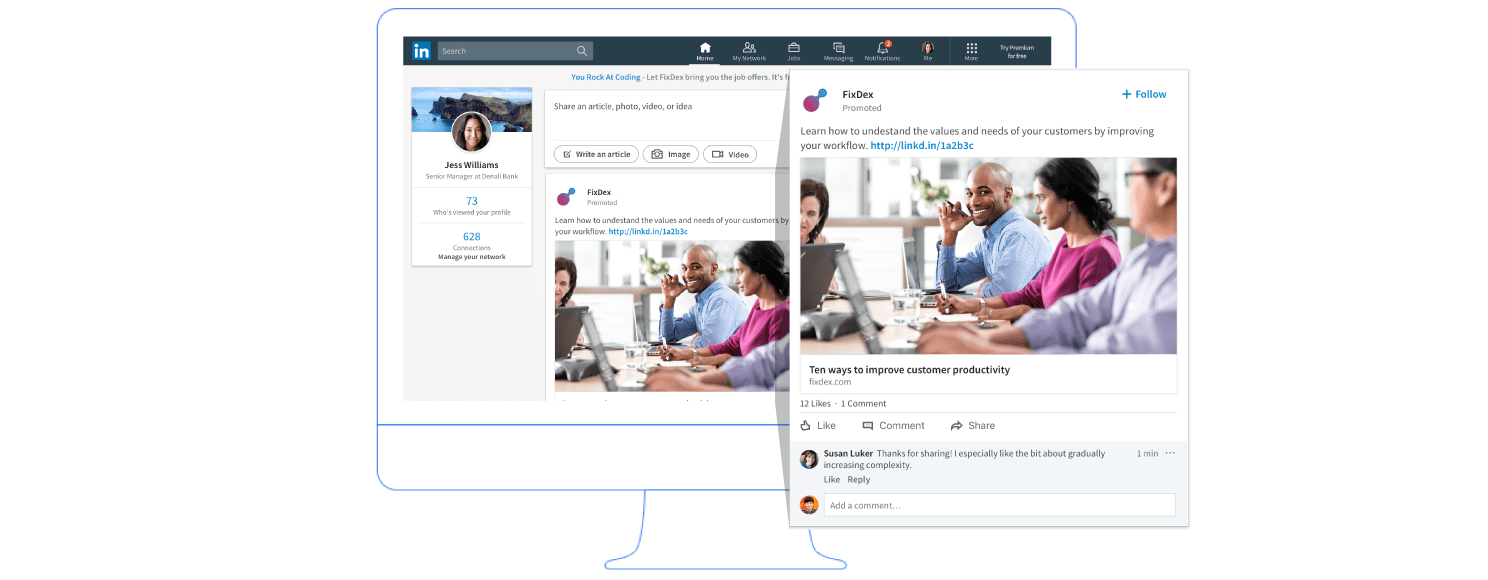
Sponsored InMail
Sponsored InMail is similar to email marketing, except that the messages go directly to users’ LinkedIn inboxes. However, Sponsored InMail has an interesting unique feature. Users only receive ad messages while they are active on LinkedIn. That means messages don’t sit around getting stale.
Here’s an example of an ad I received from the college I attended. l’m not connected to the sender on LinkedIn, but I do list the college in my profile. This made for easy and effective targeting.
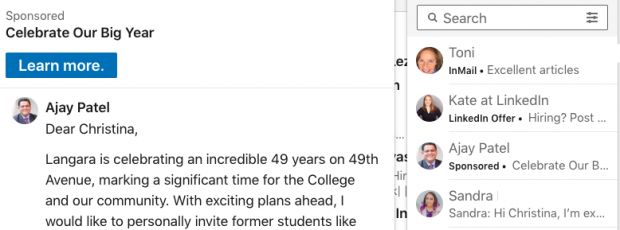
Quick tip: Short body text (under 500 characters) gets the highest click-through rate. The top five performing calls-to-action for Sponsored InMail are:
Try
Free
Today
Click
Apply
Text Ads
Text ads are small ad units that appear at the top and the right of the LinkedIn news feed. They only appear to desktop users, not on mobile devices. Despite the name, text ads can actually include a thumbnail image of 50 x 50 pixels.
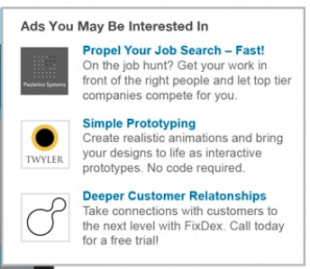
Quick tip: Show a human face. Profile images work better than logos or pictures of objects.
Get all the step-by-step instructions you need to set up your LinkedIn ads in our LinkedIn advertising guide.
Pinterest ads
Pinterest ads work with six types of business goals:
Build brand awareness
Drive traffic to your website
Drive app installs
Drive traffic to specific products
Encourage specific actions on your website
Drive video impressions
Audience considerations: Pinterest has significantly more female users than males. According to the Pew Research Center, 42% of U.S. women use Pinterest, compared to just 15% of U.S. men.
People use Pinterest to save ideas. That means the network naturally leads to shopping and purchases, but those purchases may not happen right away.
Pinterest ads are called Promoted Pins. They look and behave just like regular pins. The only difference is that you pay to have them seen by a wider audience.
Besides basic photo Pins, you can create Promoted Pins with video or a carousel of up to five images.
Promoted Pins are identified as ads with a small “Promoted” tag. However, if users save your ads to their Pinterest boards, that promoted label disappears. These saves Pins earn you bonus organic (free) exposure.
There are a couple of options for promoting your Pins.
Pinterest Ads Manager
Using the ads manager, you begin by selecting a goal for your Pinterest ads campaign. You can target your advertising strategy to align with your business goals, including whether you pay per click or per impression.
Quick tip: Since Pinterest is used for planning and generating ideas, it has a longer lead time than some other social networks. Start running Pinterest ads tied to a seasonal or date-specific campaign about 45 days in advance. And try getting creative with the DIY nature of Pinterest as a social network.
For example, Philadelphia Cream Cheese promotes their product with ads featuring recipes.

Notice that the original ad is identified as promoted. However, if a user saves the ad, it lives on as an organic post.
Promote Button
Using the Promote button, you can create an ad from an existing Pin in just a couple of clicks. Promoted Pins created with the Promote button are always pay-per-click, so you only pay when someone clicks through to your website.
Quick tip: This is a really easy way to get started with Pinterest advertising. Try promoting some of your best-performing Pins to get a sense of the kind of reach you can achieve with your desired budget. Make sure to track results over time to see the effects as people save your Promoted Pins to their own boards.
Get all the step-by-step instructions you need to set up your Pinterest ads in our Pinterest advertising guide.
YouTube ads
YouTube ads can help you work towards the following business goals:
Collect leads
Drive website traffic
Increase product and brand consideration
Build brand awareness and extend your reach
Audience considerations: YouTube has more male than female users. The audience is well spread out among age groups up to 65.
There are a few different video ad formats available on YouTube. Since Google owns YouTube, you’ll need a Google AdWords account to create YouTube ads.
TrueView Ads
These ads automatically play before, during, or after other videos on YouTube. They can also appear in other places in Google’s display network, such as apps or games.
Users get the option to skip your ad after five seconds. The recommended video length is generally 30 seconds or less.
However, if you have a compelling story with great visuals, you can run longer. Majestic Heli Ski uses longer YouTube ads to show off their incredible experiences.
Half of their customers now find them through YouTube.
Quick Tip: Seventy-six% of viewers skip ads by default. However, a skipped ad still increases the chances someone will visit or subscribe to your channel by 10 times. Make sure to get your most important messaging and branding in those unskippable first five seconds.
Non-Skippable YouTube ads
These are short ads that appear either at the start of a video or at the midpoint of a video at least 10 minutes long. The ads are a maximum 20 seconds long, and they can’t be skipped.
Quick Tip: Just because users can’t skip the ad doesn’t mean they’ll watch. Make sure your audio message is compelling in case they look away to do something else while your ad plays.
Bumper Ads
These ads are also unskippable, but they’re a maximum of six seconds long. They appear at the end of YouTube videos.
Quick Tip: Don’t try to do too much in six seconds. Start with a strong visual, stick to one message, and leave enough time for your call to action.
Get all the step-by-step instructions you need to set up your YouTube ads in our YouTube advertising guide.
Social media advertising cost
There’s a social media ad solution for every budget, from just a few dollars a day to million-dollar campaigns.
Ads on most social networks are sold in an auction format. You set a maximum bid for a target result (such as a click), or a maximum budget per day. There’s no set amount to pay. As you create your ad, the ad manager interface will provide a recommended bid based on your stated goals.
You will generally pay using one of these methods, depending on your campaign goal:
Cost per click (CPC)
Cost per 1000 impressions (CPM)
Cost per conversion
Cost per video view
Several factors impact how much you will pay for a social media ad, beyond what your competitors are bidding. These factors include:
The quality of your ad
Your campaign objective
Which type of audience you are targeting
The country you’re targeting
Time of year, and even time of day
Placement within the network.
For example, research by AdEspresso shows that the average Facebook CPC is $0.40 on Sundays, but nearly $0.50 on Tuesdays and Thursdays.
Social media advertising tips
1. Know what business objective you’re trying to achieve
It’s no accident that we start each section of this guide by reviewing the business objectives each type of social media ads can help you achieve. It’s awfully hard to achieve your goals if you don’t know what your goals are in the first place.
Understanding your business objectives is critical. It ensures you choose the right social network to advertise on. It helps you choose the right advertising solution within that platform. It even guides your creative strategy.
2. Know your target audience
We’ve listed some audience considerations for each of the social networks. Keep in mind that they all offer quite specific ad targeting. Know exactly who you’re trying to reach to take maximum advantage of these targeting options. This ensures you get the best bang for your advertising buck.
After all, there’s no point in advertising to soccer moms in Florida if your audience is young male video gamers in New Jersey. The ability to micro-target your ad campaigns is one of the key benefits of social media advertising. Developing audience personas can help you understand exactly which audience segments to focus on.
3. Let your organic posts inform your ads
You’re likely already posting content on Twitter, Facebook, and Instagram every day. Maybe LinkedIn and SnapChat, too.
Some of these posts will resonate with followers; others won’t. Track which ones are being clicked, liked, shared, and commented on. These high-performing messages make the best candidates for social ads.
If you’re branching out into a new network with your social media advertising, start small. Use what you’ve learned from your organic posts as a starting point. However, know that those lessons will not necessarily translate across social networks.
4. Pay for what matters: Impressions or engagement
To keep your budget under control, think about whether you want impressions or engagements.
If you’re paying every time someone sees your ad (impressions), your message can cast a wide net. But if you’re paying for engagement, you only want people who are really interested in doing business with you to engage. You don’t want to pay for engagements that are not relevant to your business goals. The wording of your ad should help people identify whether it’s for them or not.
Both engagement and impressions campaigns can be valuable for your business. You just need to choose the right one to align with your business goals so that you only pay for real business results. Here’s some more information about which metrics to track to make the most of your social ad campaign.
5. Design your ads with mobile in mind
More than 3.25 billion active social media users access social networks through a mobile device.
That means most social media ads are being viewed on mobile devices. Your mobile ads should be specifically designed for the small screen. Incorporate images that are easy to view on a pocket-sized device. (Unless, of course, you specifically choose desktop placement.)
If you have a bricks-and-mortar business, you can use “geofencing” to target mobile users when they are in a specific zip code. This means they only see your ads when they are close enough to walk in your front door.
6. Test your ads to optimize performance
One of the great benefits of social ads is instant feedback. You can gauge the effectiveness of a sponsored post in minutes and follow up with advanced analytics reports. The best practice is to test several ads with small audiences to determine what works best, then use the winning ad in the primary campaign.
Testing one ad against another to determine what works best and refine your strategy is known as A/B testing. It’s a critical part of your social media advertising efforts. We’ve got a full guide on how to do it right here: Social media A/B testing.
7. Measure results—and report on them
Just as it’s important to know your goals before running an ad campaign, it’s important to measure results. This will let you know whether you’ve hit your targets. It shows you what worked and what didn’t so that you can improve going forward.
Measuring your results and having concrete data about the value your ads bring to the company (purchases, leads, and so on) is a key part of proving ROI. And if you can prove that your ads are paying off, that will ensure you get the budget you need to continue your work.
The major social networks offer analytics to help you measure the results of ads. We’ve created in-depth guides on how to use them:
Facebook analytics
Instagram analytics
Twitter analytics
LinkedIn analytics
Snapchat analytics
Pinterest analytics
You can also use tools like Google Analytics and Hootsuite Impact to measure results across networks from a single dashboard. A social media report is a great way to track your results and look for great content to promote with social ads.
Prove (and improve) your social media advertising skills by taking Hootsuite Academy’s industry-recognized Advanced Social Advertising course.
The post Social Media Advertising 101: How to Get the Most Out of Your Ad Budget appeared first on Hootsuite Social Media Management.
Read more: blog.hootsuite.com
